PHOTOGRAPHY CATH MUSCAT
Sign up to our mailing list for the best stories delivered to your inbox.
Matilda Brown and Scott Gooding share their favourite dishes from The Good Farm Cookbook.
WORDS EMMA MULHOLLAND
It was a Thursday night and her youngest two had already crashed, but Til, her husband and her 16-year-old stepson sat down to jacket sweet potatoes topped with venison ragu (made with wild-harvested meat from Albury’s Wolki Farm) and golden, oozy cheese. It’s a far cry from the food she used to eat, back when she was making TV and oscillating between vegan and vegetarian diets.
“I was constantly hungry,” says Til, 37, who explains that she also struggled with an eating disorder. That changed when the actress, writer and director (and daughter of entertainment royalty Rachel Ward and Bryan Brown) met her now-husband, Scott Gooding. A cook, nutrition coach and former My Kitchen Rules contestant, Scott helped Til see the value of healthy fats and ethical meat production.
At about the same time, Til’s mum had a revelation of her own. Having faced 2019’s Black Summer bushfires, she found herself despairing at the state of the planet. So she did what she could: working with her farm manager, Rachel set about converting the family’s cattle operation in the Nambucca Valley, New South Wales, to regenerative practices (a process documented in her 2023 film, Rachel’s Farm).
She and Bryan had bought the farm on a whim in 1985, while filming in the area. Til, who came along two years later, has fond memories of the “shabby” weatherboard farmhouse and the 100 hectares beyond. “As a child, the farm was a place to run wild,” she writes in The Good Farm Cookbook.
“As a teen, it was family time and an escape from the city,” she continues. “As an adult, it has been a place of solace and a writing den. And now, as a mother, I see my kids enjoying it for all the same reasons I did when I was their age.”
Inspired by Rachel’s work, Til and Scott have become outspoken advocates for regenerative agriculture, which they support via the business they launched in 2021, a ready-meals delivery service called The Good Farm Shop.
Some of their bestsellers – chilli con carne, fish pie and Til’s Veggie Curry – feature in the couple’s just-launched book, along with meals Scott cooks for their three children (Tashi, 16, Zan, five, and Anouk, three). In a nutshell, it’s protein-packed, gluten-free fare that turns affordable cuts – chuck, mince and kidneys – into something special. Because if there’s one thing Scott loves, it’s so-called “secondary cuts”.
“I’m choosing them because they’re bloody tasty,” he insists. “We’re not afraid of marbling or connective tissue – it’s just that some of these things require a bit more work to make them tasty.”
And there are health benefits, too. “If you look at a beef cheek before you cook it,” he says, “it’s just riddled with all this connective tissue. When you expose that to heat over a long period of time, it breaks down – and we need that connective tissue. That, in its simplest form, is the collagen and gelatine that helps to provide nutrients for our soft tissue.”
In the business’s earliest incarnation, they were taking whole bodies off Rachel’s farm. But with eye fillets, scotch and T-bone in high demand, they soon found themselves with a glut of mince and chuck.
“I started turning those into the dishes I grew up with,” says Scott, whose parents ran pubs in London for 40 years. “So, lots of very classic, familiar dishes like stroganoff, shepherd’s pie and steak-and-kidney pie. Then they started to do as well as – then better than – the sales of fresh meat.”
When he and Til couldn’t turn a profit with the butchery business, they ramped up the ready-meals side of the business, maintaining their commitment to regen farming by sourcing most of their ingredients from producers that prioritise the health of their soil and use minimal chemical inputs.
Here, we feature a couple of hearty recipes from The Good Farm Cookbook. To start, we have Til’s dad’s favourite dish: a perfectly cooked steak. (It seems he’s a man of simple tastes. As Til writes of her parents: “Despite their fame, they keep it very real. In fact, I can pretty much guarantee you’ve never seen more of a sh–box than the car my dad drives.”)
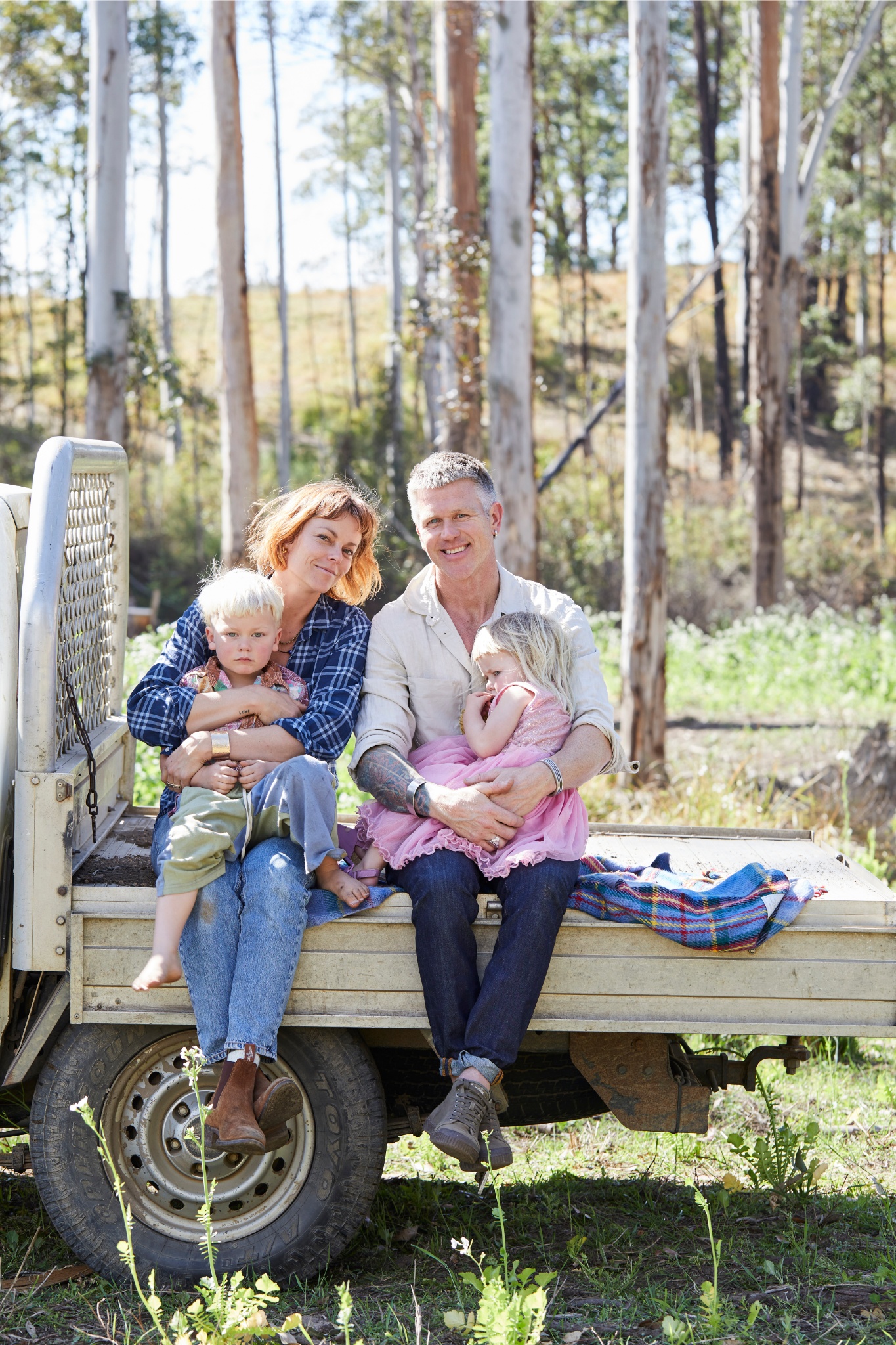
PHOTOGRAPHY CATH MUSCAT
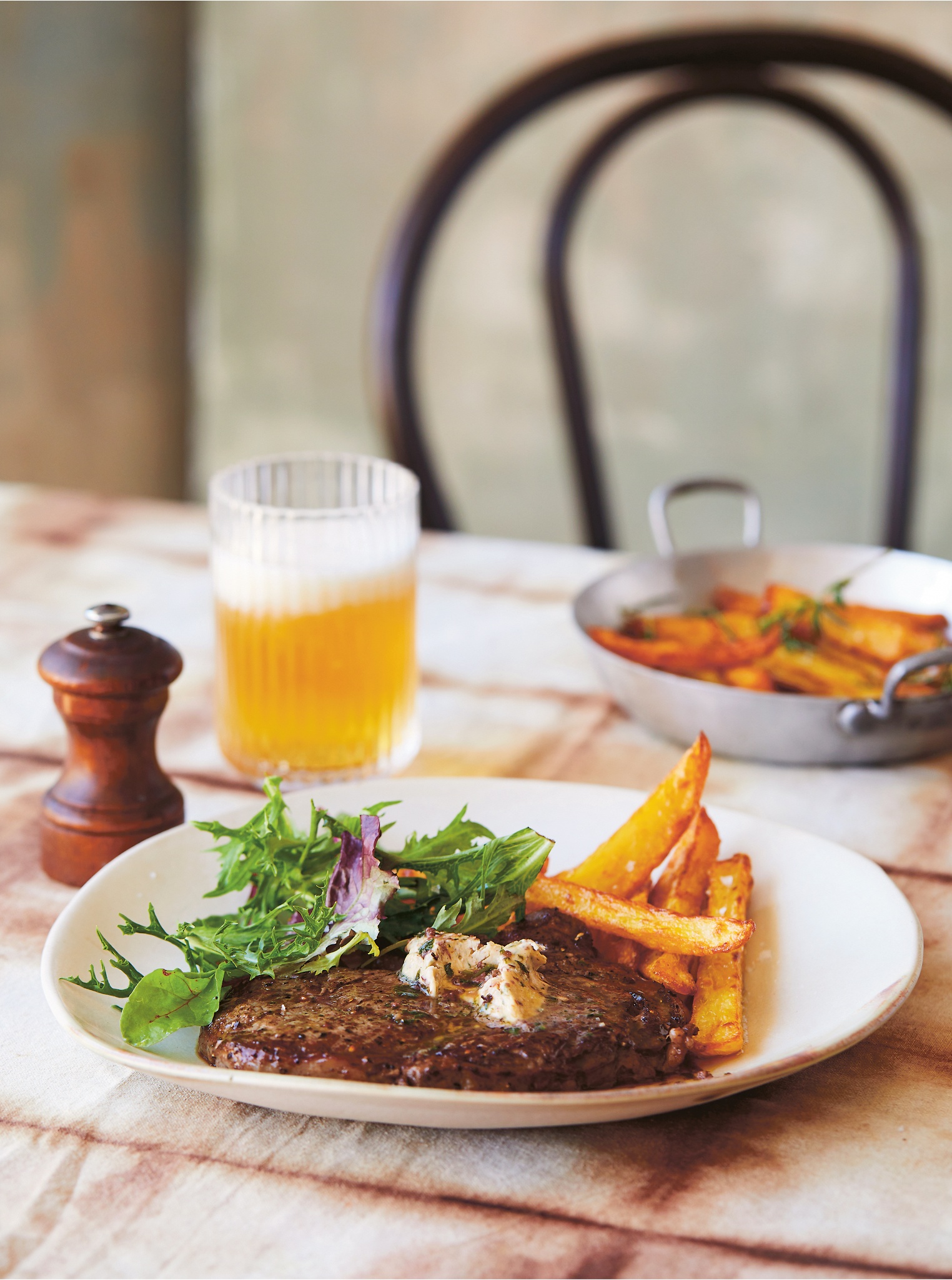
PHOTOGRAPHY CATH MUSCAT
Bryan’s Steak and Chips with Black Olive Butter.
BRYAN’S STEAK AND CHIPS WITH BLACK OLIVE BUTTER
SERVES 2
400 g (14 oz) floury potatoes, such as russet, peeled, rinsed and cut into 1.5 cm (5/8 inch) batons
100 ml (31/2 fl oz) extra-virgin olive oil, plus 1 teaspoon extra for cooking the steak
1 teaspoon dried rosemary
2 steaks (eye fillet, scotch fillet, T-bone and rump are excellent choices)
2 tablespoons Black Olive Butter (below)
Bring a saucepan of salted water to the boil and drop in the potatoes. Return to the boil before reducing the heat to a steady simmer for 12 minutes. Drain, and lightly toss them in the colander to ‘rough up’ the surface of the potato. Place in a container (uncovered) and freeze for 1–2 hours.
Once the potatoes have chilled, preheat the oven to 220°C (425°F).
Place the olive oil in a baking dish with the dried rosemary and put in the oven for 5 minutes before adding the potatoes.
Return the dish to the oven and bake for 30–40 minutes, or until golden, turning a few times to ensure the chips are evenly crisp.
Remove the steaks from the fridge and set aside.
With about 10 minutes left on the chips, place a heavy-based frying pan over high heat.
Season both sides of the steaks. Add the extra olive oil to the pan and, once hot, add the steaks. If your steak is about 2 cm (3/4 in) thick, cook them for around 3 minutes on each side for medium rare (adjust the cooking time depending on the thickness of the steak and how you like it cooked). Don’t move the steaks for the first 3 minutes – this will create a lovely caramelised crust. Once this has developed, turn them over.
With 1 minute remaining on the steaks, add 1 tablespoon of the butter to the pan and baste the steaks with it. Once cooked to your liking, remove the steaks from the pan and rest for 2–3 minutes. Remove the chips from the oven and season.
Place the steak on a serving plate and top with the remaining butter. Serve with the chips and a green salad, if you like.
BLACK OLIVE BUTTER
MAKES 175 G (6 OZ)
150 g (51/2 oz) salted butter
2 garlic cloves, peeled
50 g (13/4 oz) black olives, pitted
2 anchovy fillets
1/4 bunch fresh parsley
Combine all the ingredients in a food processor or blender and blitz for 20 seconds or until smooth. Taste and adjust the seasoning, then transfer to an airtight container and store in the fridge for up to 1 month.
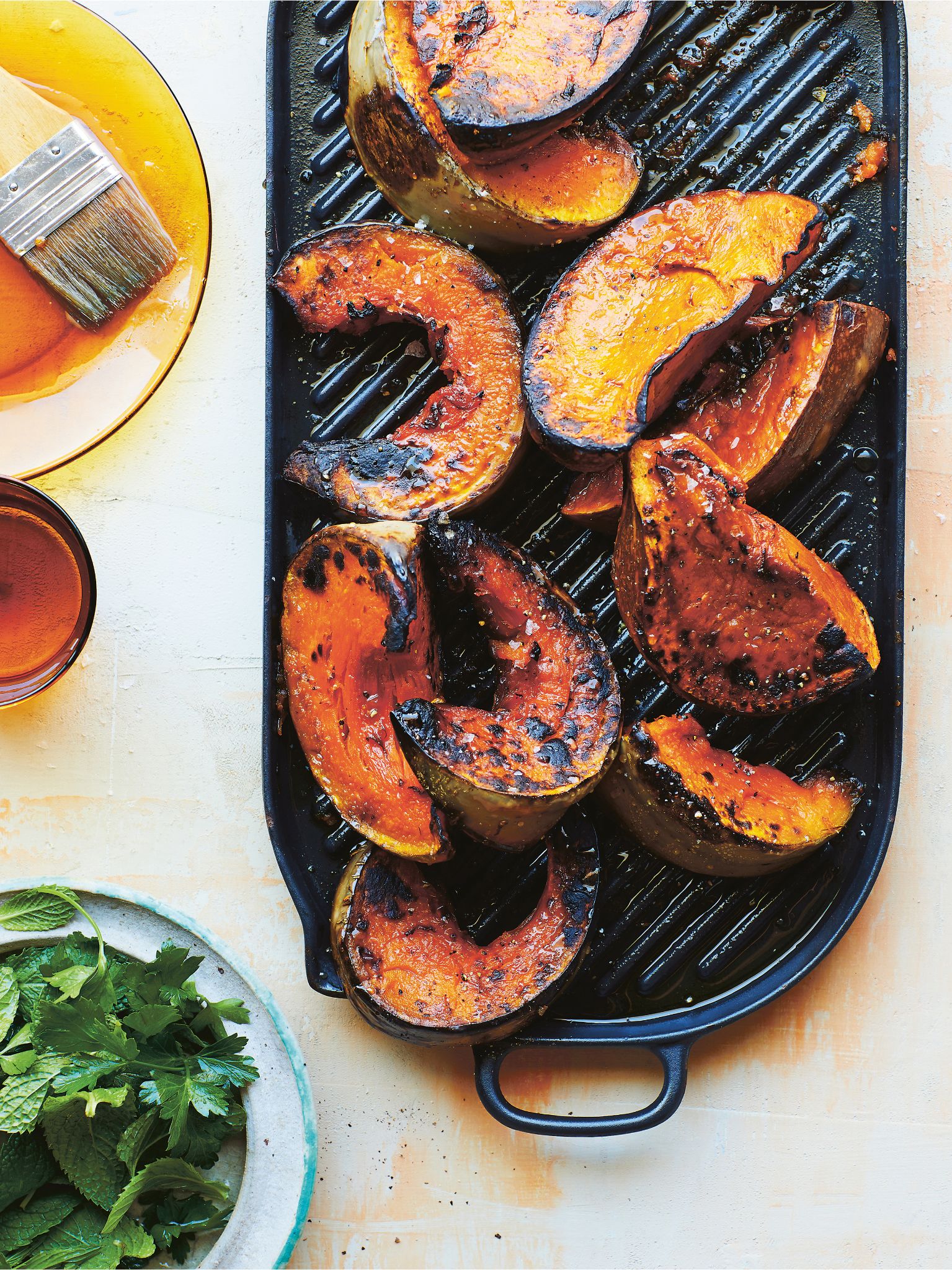
PHOTOGRAPHY CATH MUSCAT
Campfire-roasted Pumpkin with Spiced Maple Glaze.
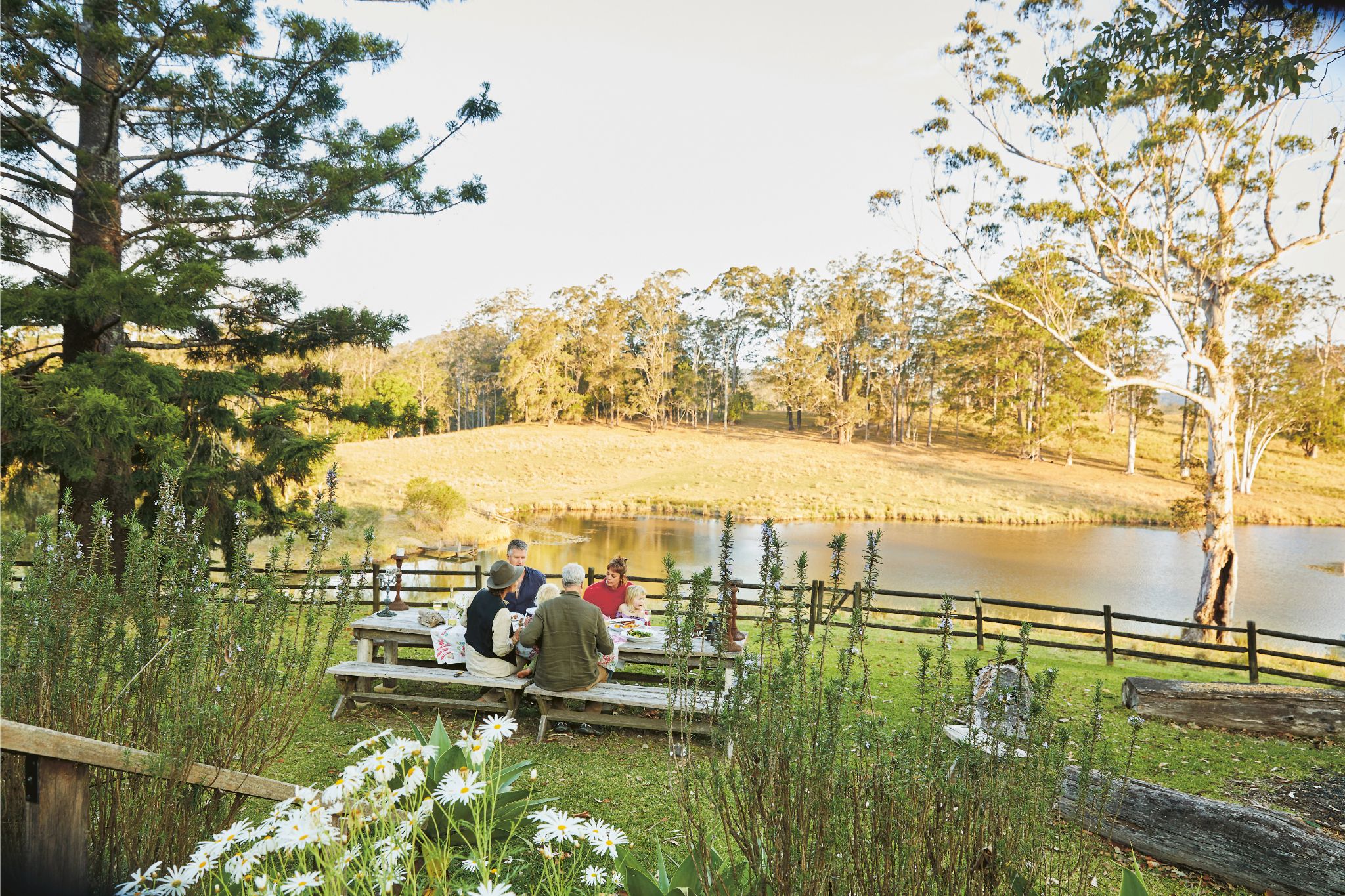
PHOTOGRAPHY CATH MUSCAT
CAMPFIRE-ROASTED PUMPKIN WITH SPICED MAPLE GLAZE
SERVES 8–10
1 whole Jap pumpkin (squash)
2 tablespoons extra-virgin olive oil
1/4 cup (60 ml) maple syrup, or honey
1 teaspoon ground cinnamon
1/2 teaspoon ground nutmeg
1/4 teaspoon ground cloves
Once the campfire has died down to hot coals, cut the pumpkin in half and scoop out the seeds and pulp using a spoon. Cut into generous chunks or slices.
Combine the olive oil, maple syrup and spices in a large mixing bowl, then brush the glaze on to the pumpkin. Season well with salt and pepper.
Place the pumpkin directly on the hot coals using some long tongs.
Leave until the pumpkin caramelises on one side, then gently turn to caramelise all sides. It should take about 20 minutes to cook through.
Remove from the heat and allow to cool before serving.
APPLE CRUMBLE WITH STAR ANISE AND HEMP
SERVES 10–12
APPLES
1.25 kg (2 lb 12 oz) apples, cored and cut into 3 cm (11/4 inch) wedges
2 tablespoons ground cinnamon
1 teaspoon ground star anise
1 teaspoon ground cardamom
1/2 teaspoon ground nutmeg
2 tablespoons coconut sugar
TOPPING
2–3 tablespoons coconut sugar, or sugar of your choice
2 cups (130 g) shredded coconut
1 cup (170 g) hemp seeds
1 cup (125 g) slivered almonds
1 tablespoon ground cinnamon
1/2 cup (125 g) salted butter, roughly chopped
Place the apple in a large mixing bowl and sprinkle the spices and coconut sugar over the top. Toss to ensure the apples are evenly coated.
Transfer to a saucepan with 300 ml (10 ½ fl oz) water, cover with a lid and place over low heat.
Leave the apples to stew gently for about 45 minutes, mixing every 10 minutes or so with a wooden spoon.
Meanwhile, make the topping by combining the sugar, coconut, hemp seeds, almonds and cinnamon and tossing together.
Add the butter and use your hands to rub it into the topping ingredients to form a crumb.
Preheat the oven to 150°C (300°F).
Once the apples have softened, remove the pan from the heat and transfer the apple mixture to a baking dish.
Sprinkle the topping over the apples and place in the oven for 15 minutes, or until the topping has browned.
Remove from the oven and enjoy with some home-made ice cream (see below).
SALTED CARAMEL AND HONEY NO-CHURN ICE CREAM
SERVES 6
SALTED CARAMEL SAUCE
1 cup (250 ml) maple syrup, or honey
6 tablespoons unsalted butter
1/2 cup (125 ml) thick (double) cream
1 teaspoon sea salt, or to taste
ICE-CREAM BASE
2 cups (500 ml) thick (double) cream
1/3 cup (115 g) honey
1 teaspoon vanilla extract
3 egg yolks
To make the salted caramel sauce, have all the ingredients ready to go because it can come together quickly.
Warm the maple syrup in a heavy-based saucepan over medium heat, stirring constantly until it becomes a deep amber colour and thickens slightly. This should take 5–7 minutes.
Once the maple syrup reaches the desired colour, add the butter all at once. Be careful; it will bubble up. Stir until the butter is completely melted and combined.
Slowly pour in the cream, stirring continuously. Be cautious as it may bubble up again if you pour too much in at once. Continue to cook and stir for another 1–2 minutes until the caramel is smooth and slightly thickened.
Remove the caramel sauce from the heat and stir in the sea salt. Taste and adjust the saltiness if necessary. Set aside to cool slightly, then transfer to an airtight container and place in the freezer for 20 minutes to chill and thicken.
In a mixing bowl, whip the cream until stiff peaks form, then place in the fridge to keep cool.
In a small saucepan set over low heat, melt the honey and mix in the vanilla extract.
Place the egg yolks in the bowl of a stand mixer and beat on high for 5 minutes. You can also use a mixing bowl and a handheld electric mixer for this. Slowly pour the honey mix into the beaten egg yolks. Continue beating until the mixture thickens, about 4–5 minutes.
Add the whipped cream and gently fold in, being careful not to deflate the cream too much.
Pour about half of the ice-cream mixture into a container. Drizzle one-quarter of the chilled salted caramel sauce over the ice cream.
Add the remaining ice cream mixture, then another one-quarter of the sauce. Use a knife or skewer to swirl the caramel through the ice cream to create a marbled effect.
Cover the container with a sheet of baking paper and freeze for at least 4–6 hours, or until the ice cream is firm.
Serve the extra caramel sauce on the side for pouring over the ice cream (like Ice Magic). This dessert is perfect with a side of berries.
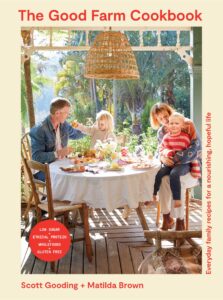
If you or someone you know may be living with an eating disorder, call the Butterfly Foundation‘s national helpline on 1800 334 673.
Images and recipes are from The Good Farm Cookbook by Scott Gooding and Matilda Brown, photography by Cath Muscat (Murdoch Books, RRP $39.99).
Subscribe to Graziher and never miss an issue of your favourite magazine! Already a subscriber? You can gift a subscription to someone special in your life.
To hear more extraordinary stories about women living in rural and regional Australia, listen to our podcast Life on the Land on Apple Podcasts, Spotify and all major podcast platforms.
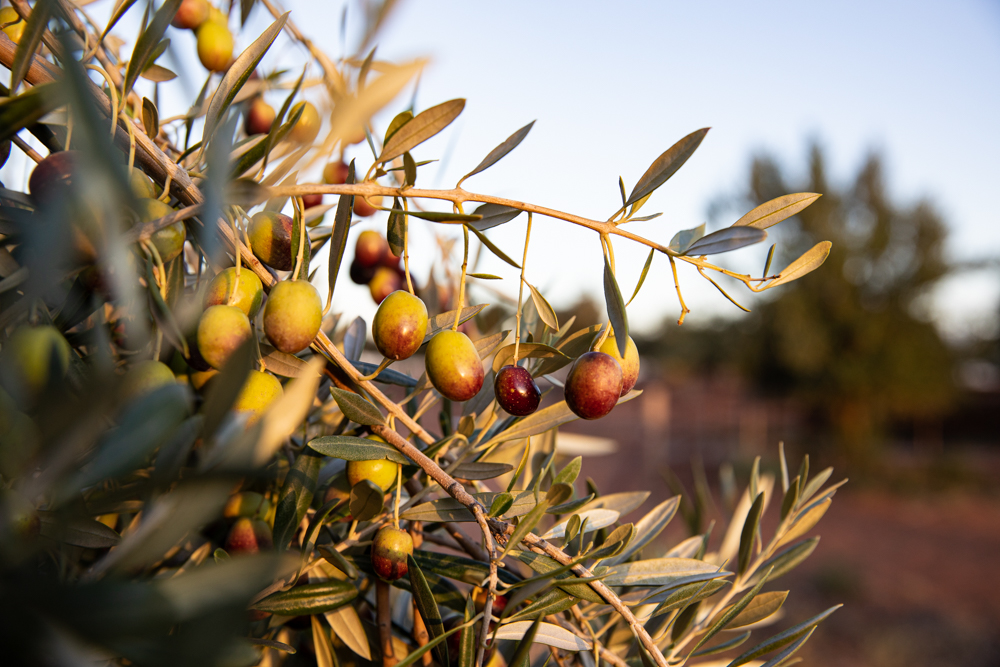
The Shady Baker celebrates this year’s bountiful olive harvest with recipes highlighting both the oil and the fruit.
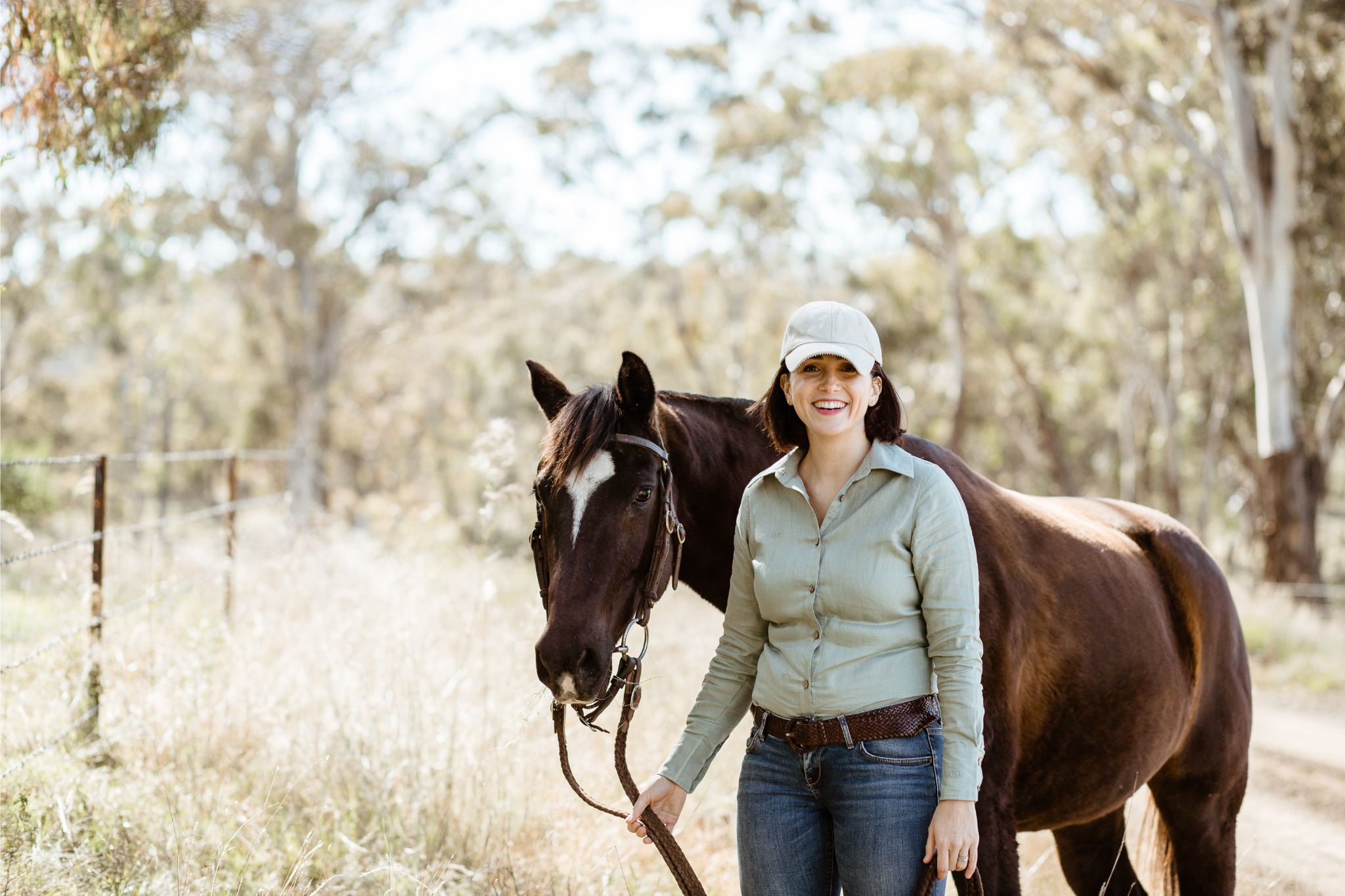
Today, her role at Australian Organic is all about educating others.
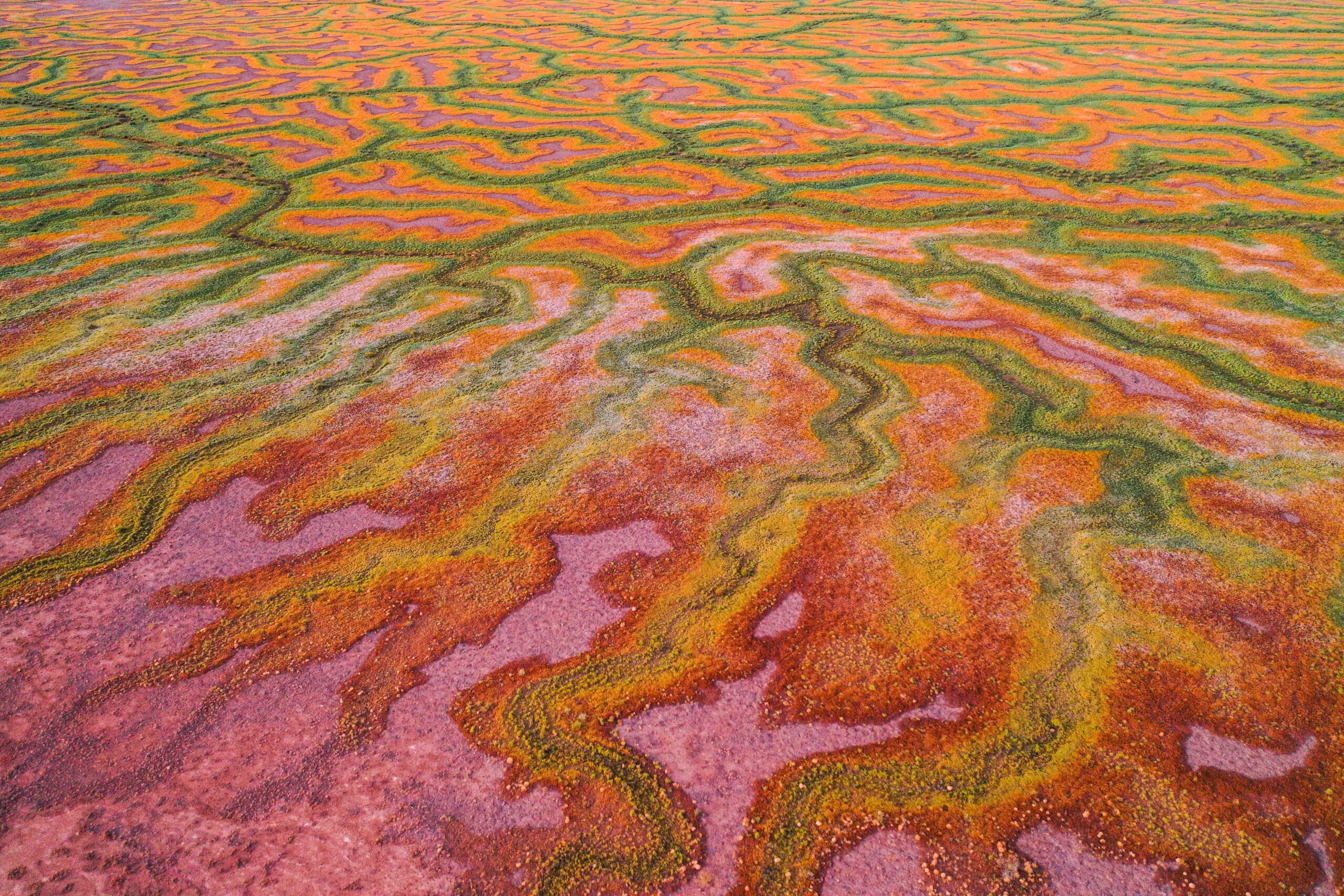
Meet the fifth-generation sheep and cattle farmer behind the image selected for the 2026 Graziher wall planner, which comes free with the next issue.

She says it’s less work than you might think — and provides income stability when times are tough.